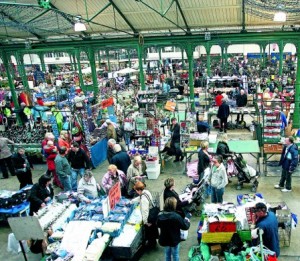Belfast Narrative
Posted By: August 26, 2013
Tourists just cannot get enough of city’s narrative
Tom Kelly. Irish News (Belfast). Monday, August 26, 2013
AS THE politicians are sunning themselves abroad, writing ‘Dear John’ letters to their love lorn partners or taking PSNI charter tours of North Belfast, I decided to take a break too. So at the weekend – Mrs in tow, I became a Belfast tourist. It’s an interesting experience to see a city through the eyes of a visitor especially when one works in that city. When you take the time to look, Belfast is a very attractive city with its many fine Victorian buildings sitting comfortably beside cutting edge new designs such as Victoria Square, Titanic Belfast, the Mac and the Waterfront. It’s easy to see why Belfast grew so quickly in the 19th century as its grandeur must have made it look like a mystical Oz to the bumpkins from the sticks who came hoping for better life. There was nothing inclusive about Victorian Belfast as a quick scan of its statues will tell. The city’s father and merchant class was by and large of one political outlook. Sectarianism was rife and even encouraged and the legacy of that is carried on today in its Victorian back streets divided by the incredibly misnamed ‘peace wall’. Even today, Belfast is a city competed for politically, culturally and territorially the by Catholic and Protestant descendants of both mill workers and Yardmen. But this is all part of Belfast’s narrative and the tourists just can’t get enough of it as they explore the gory murals and murderous landmarks that pepper the landscape of the city. Personally speaking, I could forgo these tragic tours as they turn Belfast and more particularly its people into an anthropological zoo. Mind you the pictures that fed the world’s media over the past summer may be proof that the primitive sectarianianus Neanderthal and the self-hating homo erectus still roam Belfast, turning parts of it into a massive Jurassic park for bigots. Yet civilisation and normality is only ever a few streets away. Without a shadow of a doubt St George’s Market is Belfast’s crowning gem. It’s where Belfast artisans meet galloping gourmands and chic urbanites seek out hand reared classical music loving wagu beef from the slopes of Slemish or where you can pick up anything from oriental spices to Aunt Jane’s homemade rhubarb and ginger jam.
Think Covent Garden with attitude. While city councillors fall over themselves with ecstasy for the annual arrival of the continental market at the city hall, it’s St George’s with its talkative stall holders, haranguing fish mongers and eclectic mix of Belfast’s new migrant artists and purveyors of fine foods that are the real soul of the new city for local and tourist alike. A quick run up the increasingly more stable and affluent looking Falls Road with its fine public housing and impressive public play spaces contrasted starkly with a run down the Shankill Road, which looked liked a foreign country to our border eyes as bandsmen and their supporters drank on streets swamped with union and loyalist flags. The bandsmen formed long queues outside dodgy looking fast food joints and dingy looking clubs, whilst their girlfriends wore skimpy t shirts emblazoned with logos proclaiming ‘I love Protestant Belfast.’ While the Falls appears more confident and positively embracing of tourists, tourists are more of a rarity on the Shankill Road where they are viewed with more suspicion. The highlight of my tourism special to Belfast was our visit to the Crumlin Road Gaol. The prison has been like a finishing school for many of our political classes as half of Stormont seems to have passed through its gates. It is a fine state of affairs when your government is populated with people who had have more prison visitors than school dinners. Yet ‘the Crum’ as its inmates affectionately called it, is unique in political significance as everyone from De Valera to Paisley found themselves availing of its hospitality. Even my own grandfather, Tom Kelly found himself an involuntary visitor during the War of Independence in 1921. The Irish suffragettes are also part of the prison’s grisly history. The Crumlin Road gaol is an example of what the Maze could be like with different narratives told side by side but only the Crum has nostalgia. Whilst talking to a fellow Derry tourist about the possible incarceration of GAA pundit Joe Brolly and the Belfast spide who stole my sun glasses, quite literally from under my nose, I felt that Belfast was, as Dervla Murphy once wrote of Northern Ireland, still a place apart albeit for better reasons.











